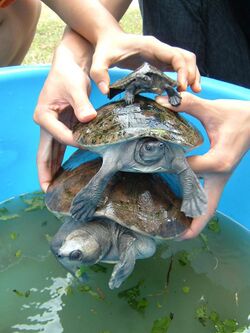Biology:Southern river terrapin
| Southern river terrapin | |
|---|---|

| |
| (Batagur affinis) from a gazetted conservation site at Kuala Berang, Terengganu, Malaysia | |
| Scientific classification | |
| Domain: | Eukaryota |
| Kingdom: | Animalia |
| Phylum: | Chordata |
| Class: | Reptilia |
| Order: | Testudines |
| Suborder: | Cryptodira |
| Superfamily: | Testudinoidea |
| Family: | Geoemydidae |
| Genus: | Batagur |
| Species: | B. affinis
|
| Binomial name | |
| Batagur affinis (Cantor, 1847)[3]
| |
The southern river terrapin (Batagur affinis)[3] is a turtle of the family Geoemydidae found in Malaysia, Indonesia and Cambodia.[4]
Subspecies
Decline
Many Asian turtles are in danger because of the thriving trade in animals in the region, where a species' rarity can add to its value on a menu or as a traditional medicine.
The species was thought to have disappeared from Cambodia until it was rediscovered in 2001. Conservationists eventually began tagging the animals with tracking devices and monitoring their nests, and King Norodom Sihamoni personally ordered their protection. [5] Its eggs were a delicacy of the royal cuisine of Cambodia. In 2005, it was designated the national reptile of Cambodia in an effort to bring awareness and conservation for this species.[6] In July 2015, conservationists in Cambodia cautiously stated that efforts to bring back the species from the brink of extinction were having some success. A number of turtles, including breeding pairs, have been moved from enclosed areas into their intended home, the rivers and shores of Koh Kong where, it is hoped – with the ongoing monitoring and protection of locals and conservationists – they will begin to flourish.[7] They began their conservation effort by ensuring the safety of the hatchlings through fencing the nesting area of the species, given that the extremely low number of nests laid already.[8]
In Malaysia, rivers of Kedah, Perak and Terengganu are major nesting grounds though the population continues to crash despite conservation efforts undertaken by Malaysian Wildlife Department for over 20 years. Pasir Temir and Pasir Lubuk Kawah by the Terengganu River are the largest nesting sites for Batagur baska in the world.
See also
References
- ↑ Horne, B.D.; Chan, E.H.; Platt, S.G.; Moll, E.O. (2019). "Batagur affinis". IUCN Red List of Threatened Species 2019: e.T170501A152041284. doi:10.2305/IUCN.UK.2019-1.RLTS.T170501A152041284.en. https://www.iucnredlist.org/species/170501/152041284. Retrieved 19 November 2021.
- ↑ "Appendices | CITES". https://cites.org/eng/app/appendices.php.
- ↑ 3.0 3.1 Rhodin 2010, pp. 000.107
- ↑ 4.0 4.1 4.2 Rhodin 2010, pp. 000.107-000,108
- ↑ Platt, S.G.; Bryan L. Stuart; Heng Sovannara; Long Kheng, Kalyar and Heng Kimchhay (2003) "Rediscovery of the critically endangered river terrapin, Batagur baska, in Cambodia, with notes on occurrence, reproduction, and conservation status" Chelonian Conservation and Biology 4(3): 691
- ↑ ROYAL DECREE on Designation of Animals and Plants as National Symbols of the Kingdom of Cambodia
- ↑ Laurenson, Jack. "‘Royal Turtle’ is Back from the Brink". http://www.khmertimeskh.com/news/14332/---royal-turtle----is-back-from-the-brink/.
- ↑ Seah, Adeline, et al. “Last Exit before the Brink: Conservation Genomics of the Cambodian Population of the Critically Endangered Southern River Terrapin.” Ecology and Evolution., vol. 9, no. 17, Blackwell Pub Ltd, Sept. 2019, pp. 9500–10, doi:10.1002/ece3.5434.
- Bibliography
- Rhodin, Anders G.J.; van Dijk, Peter Paul; Inverson, John B.; Shaffer, H. Bradley (2010-12-14). "Turtles of the World 2010 Update: Annotated Checklist of Taxonomy, Synonymy, Distribution and Conservation Status" (pdf). http://www.iucn-tftsg.org/wp-content/uploads/file/Accounts/crm_5_000_checklist_v3_2010.pdf.
External links
- Turtle Survival Alliance Blog – Southern River Terrapin (Batagur affinis)
- Turtle Conservation Society of Malaysia
- Satellites to Track Rare Royal Turtle in Cambodia (Video)
Wikidata ☰ Q2592204 entry
 |


